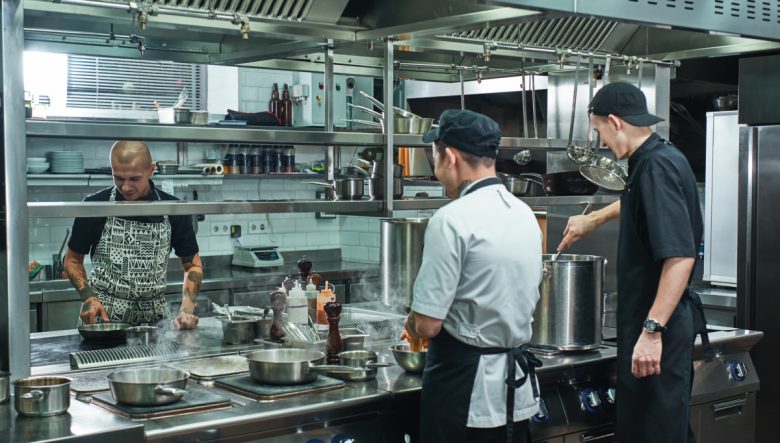Have you ever had dinner at a restaurant, and you were the only patron? This might have happened at a slow time of day, maybe between the busy lunch shift and the busy dinner shift.
But if the dining area was constantly empty, and no one was ever in the dining area, that would certainly signal a problem, right?
Not so with the newest business model in food: the ghost kitchen. Ghost kitchens – also known as virtual kitchens – have surged in popularity. Customers of ghost kitchens may not even know that they’re eating food from a ghost kitchen. That is because this type of business model is designed to work behind the scenes. Here’s all you need to know about this new food trend.
What is a Ghost Kitchen?
A ghost kitchen is a restaurant that provides food for take-out only. You may have ordered food through an app like Grubhub or DoorDash, and ordered from a ghost kitchen without even knowing it. Some ghost kitchens only offer delivery. Others provide the option of pick-up.
Some ghost kitchens have an established fan base, being established by a well-known celebrity. Other ghost kitchens begin as commercial kitchens. Without a dining room, they may use space provided by another company. They might even build a relationship with an existing company to serve their food as take-out only. This provides built-in visibility for the ghost kitchen.
A ghost kitchen business model might also be appropriate for a company that is struggling and needs to revitalize its operations.
How Does This Business Model Make Money?
Ghost kitchens are profitable through a carefully planned business strategy. If you’re starting a commercial kitchen from the ground up – without a customer base – you’ll need to select what type of cuisine you’ll sell.
You’ll also want to ensure you have a chef that can create a stellar menu. Your menu will need to stand out above the others in the marketplace.
For a new ghost kitchen – whether it’s one without any potential customers or one that is trying to identify target customers – it’s critical to create a marketing plan. Consider who your customers might be, the time of day that they will be ordering, and how easy it is to take your items to go.
Creating a simple menu will help you accelerate your profits and streamline your business profits.
Pros of the Ghost Kitchen Business Model
In 2020, the entire restaurant industry was upended by public health orders and uncertainty. Restaurant workers were faced with not knowing when they would be able to return to their jobs. Business owners were faced with financial losses and the inability to give their employees any defined time as to when their jobs might be available again.
While public health orders have lifted, restaurant owners still struggle with staffing. This can impact the customer experience, which ultimately harms the business.
The ghost kitchen model eliminates much of this hardship. Resilience is built into the business model. Ghost kitchens are ideal for establishing business-to-business relationships, just like a typical catering business would. During the pandemic, many ghost kitchens quickly adapted to offer meal kits and pre-packaged meals for customers to prepare at home.
Cost Savings
One of the primary advantages of the ghost kitchen model is that it significantly reduces overhead costs. Traditional restaurants have to factor in expenses such as rent, utilities, and staffing for both the front and back of house. Ghost kitchens, on the other hand, don’t have the added expense of a physical storefront or dine-in space, which significantly reduces rent and utility costs.
Compared to traditional restaurant owners, ghost kitchen owners save money in several areas:
- Real estate: Without a dining area, smaller space is needed.
- Monthly energy bills: Because customers aren’t eating in, there’s a smaller space to maintain. This means savings on lighting, heating, water, and repairs.
- Furniture, decor, and glassware: These start-up costs can be expensive.
Additionally, ghost kitchens can operate with a much smaller staff as they don’t need servers or hosts. In the long term, ghost kitchens save big.
Flexibility
Another advantage of the ghost kitchen model is increased flexibility. With no physical storefront or dine-in option, ghost kitchens have the freedom to change menus and pivot quickly to adapt to changing consumer trends. This flexibility allows ghost kitchens to offer a wider variety of food options, experiment with new concepts, and adjust to the demands of the market.

Cons of a Ghost Kitchen Business Model
This type of business model is unique in many ways. The ghost kitchen business model can reap some of the advantages of a restaurant without using a brick-and-mortar business model. Although there are several advantages to starting a ghost kitchen instead of a traditional restaurant, this business model still has its drawbacks.
Delayed Feedback from Customers
Reduced interactions with customers mean that if there’s a mistake on an order, there isn’t a chance to make it right then and there. Keep an eye on social media reviews so you can respond to any negative feedback. Another potential drawback is that without a physical presence, you may have to work harder to build credibility. This makes marketing essential.
Sometimes, business-to-business relationships can be created when you create a ghost kitchen. Some customers don’t care all that much where their food comes from as long as it tastes good. Others do mind. For example, if a customer had a bad experience at a local restaurant, they might just forget about it. However, later on, they might order food from a ghost kitchen affiliated with that restaurant. If they find out that the two are connected, it might influence their feelings about the ghost kitchen. Some customers might feel deceived. Others might not care.
Dependence of Technology
Ghost kitchens rely heavily on technology for online orders, delivery management, and kitchen operations. Any technical glitches or downtime could disrupt their operations and affect customer satisfaction. They are also dependent on online apps like GrubHub, Uber Eats, and DoorDash. These apps are a ghost kitchen’s bread and butter. Without a strong relationship with them, a ghost kitchen’s orders may dry up.
Delivery App Commissions
Speaking of delivery apps, there is another drawback that comes with this collaboration. Partnering with these apps also comes with commission fees. This can eat into profits as these fees can range from anywhere between 10 and 30 percent. In order to maintain profits, ghost kitchen owners will need to be sure to price their products correctly to attract customers without losing too much money. This means controlling other costs like utensils, napkins, and straws will also be important.
Examples of a Ghost Kitchen
Here are some examples of a ghost kitchen:
- Flavortown: from Chef Guy Fieri. Has no physical locations. Offers food in over 30 states
- Ghost Kitchen Brands: This company has teamed up with several different restaurants – including Quiznos – to offer customers many different food options. Food is also available through the UberEats app. They’ve also teamed up with several different Walmart locations. They’re experimenting by offering pick-up at these Walmarts.
- It’s Just Wings: a ghost kitchen offshoot of Chilli’s
- Mama Roma: a virtual brand available on DoorDash
- Mariah’s Cookies: Mariah Carey’s virtual kitchen
- MrBeast Burger: available on GrubHub
- Pasqually’s Pizza: created by Chuck-E-Cheese
Conclusion
Ghost kitchens have increased in popularity. Without indoor dining, ghost kitchens serve up delicious food on the go. To operate a profitable ghost kitchen, it’s important to have a clear business plan. While ghost kitchens do have some drawbacks, they provide a startup option without the costs of starting a traditional restaurant.














Pingback: Practise these Powerful Online Strategies To Become Irresistible To Customers ·
Pingback: The Ghost Kitchen Business Model Explained - Ikaroa
Pingback: Have you been eating from a ghost kitchen?
Pingback: The Ghost Kitchen Business Model Explained Krownjobs.com - krownjobs
Pingback: The Ghost Kitchen Business Model Explained | Entrepreneur Canada
Pingback: The Ghost Kitchen Business Model Explained – Andrea Zanon
Pingback: The Ghost Kitchen Business Model Explained – Austin Rotter